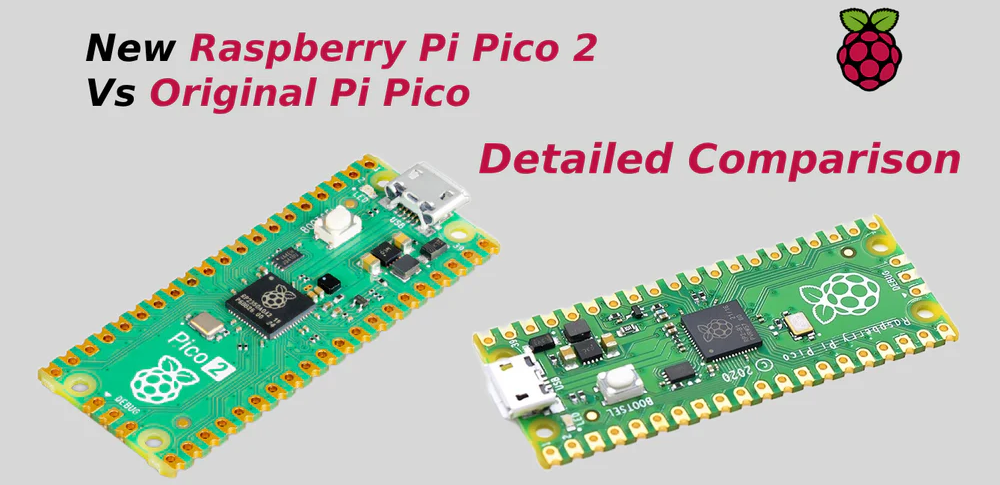The Raspberry Pi Pico has been a popular choice among electronics enthusiasts and professionals since its release, thanks to its affordability and versatility. With the introduction of the Raspberry Pi Pico 2, users now have access to even more powerful features and capabilities. Let’s dive into the key differences between these two microcontroller boards.
Microcontroller Chip
- The Raspberry Pi Pico is Powered by the RP2040 microcontroller chip, designed by Raspberry Pi in the UK.
- The upgraded Raspberry Pi Pico 2 utilises the great addition of the RP2350 to the Raspberry family, which was also designed by Raspberry Pi in the UK.

Processor
- Raspberry Pi Pico: Features a dual-core Arm Cortex M0+ processor, running at up to 133 MHz.
- Raspberry Pi Pico 2: Equipped with dual Cortex-M33 or Hazard3 processors, capable of running up to 150 MHz, providing a significant boost in processing power.
Memory
- Raspberry Pi Pico: Comes with 264KB of SRAM and 2MB of onboard flash memory.
- Raspberry Pi Pico 2: Doubles the memory with 520KB of SRAM and 4MB of onboard flash memory, allowing for more complex and memory-intensive applications.
GPIO Pins and Interfaces
- Raspberry Pi Pico: Offers 26 multi-function GPIO pins, including 3 that can be used for ADC, along with 2× SPI, 2× I2C, 2× UART, 3× 12-bit ADC, and 16× controllable PWM channels.
- Raspberry Pi Pico 2: Maintains the 26 multi-function GPIO pins but includes 3× 12-bit 500ksps ADCs and expands the PWM channels to 24. It also features 2× SPI, 2× I2C, 2× UART, and additional interfaces like 2× Timer with 4 alarms and 1× AON Timer.


Programmable IO (PIO)
- Raspberry Pi Pico: Includes 8 Programmable IO (PIO) state machines for custom peripheral support.
- Raspberry Pi Pico 2: Enhances this with 3 PIO blocks, totaling 12 state machines, offering more flexibility for custom peripheral development.
Naming Convension
The original Pi Pico chip's name RP2040 was derived from the following details of the chip:
- Number of processor cores (2)
- Loosely which type of processor (M0+)
- floor(log2(RAM / 16k))
- floor(log2(nonvolatile / 16k)) or 0 if no onboard nonvolitile storage

The upgraded Pi Pico 2 chip's name RP2350 was similiarly derived from details regarding the chip:
- Number of processor cores (2)
- Loosely which type of processor (M33)
- floor(log2(RAM / 16KB))
- flor(log2(nonvolatile / 128KB)) or 0 if no onboard nonvolitile storage

These details and pictures can be found on the official Raspberry Pi documentation page
Additional Features
- Raspberry Pi Pico: Features an accurate clock and timer on-chip, a temperature sensor, and accelerated floating-point libraries.
- Raspberry Pi Pico 2: Adds improved low-power sleep and dormant modes, flexible user-programmable high-speed IO, and the ability to emulate interfaces such as SD Card and VGA.
Form Factor and Connectivity
- Raspberry Pi Pico: Available as a castellated module for direct soldering to carrier boards, with an option for pre-soldered headers (Pico H).
- Raspberry Pi Pico 2: Also available as a castellated module, with an option for pre-soldered headers, ensuring easy integration into various projects.
What's the future of the Raspberry Pi Pico 2?
- There are rumours of a Pico 2 W releasing later this year. While it still may not be officially confirmed, looking at their previous history, there is a high lickely hood for them to continue the Pico 2 range. This may include a Pico 2 H, Pico 2 W & Pico 2 WH.
Conclusion
The Raspberry Pi Pico 2 builds on the solid foundation of the original Pico, offering enhanced processing power, increased memory, and additional features that make it an even more versatile and powerful tool for electronics projects. Whether you’re a hobbyist, educator, or professional, the Pico 2 provides the performance and flexibility needed to take your projects to the next level.

